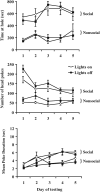Validation of a novel social investigation task that may dissociate social motivation from exploratory activity
- PMID: 19135092
- PMCID: PMC2678686
- DOI: 10.1016/j.bbr.2008.12.011
Validation of a novel social investigation task that may dissociate social motivation from exploratory activity
Abstract
The present series of studies provide validation of a new paradigm that uniquely combines the assessment of the propensity to engage in social investigation with measures of (nonsocial) exploratory activity in rats. Assessment of this social investigation paradigm indicated that (a) rats showed a robust preference for social investigation over nonsocial exploratory activity, (b) female rats showed a greater preference for social investigation than male rats, (c) no signs of habituation in these responses were observed when rats were tested once daily for 4 consecutive days, (d) the preference for social investigation was stable and robust in both the dark and light periods of the daily light cycle for 5 consecutive days, and (e) testing under bright light conditions suppressed social investigation. In addition, acute administration of opiate drugs, low dose morphine (1.0 mg/kg) and naltrexone (1.0 mg/kg) produced a more robust attenuation of social investigation than nonsocial exploratory activity. Amphetamine increased both forms of investigation and haloperidol had the opposite effect, but the overall preference for social investigation over exploratory activity remained largely intact after both amphetamine and haloperidol injection. Together, these findings validate the use of this behavioral task to assess changes in social-motivation and general exploratory activity. Importantly, the task is bi-directionally sensitive to subject characteristics (i.e., sex), drug manipulations which modulate social motivation, and environmental manipulations.
Figures





Similar articles
-
Novelty-induced place preference behavior in rats: effects of opiate and dopaminergic drugs.Pharmacol Biochem Behav. 1989 Mar;32(3):683-9. doi: 10.1016/0091-3057(89)90018-x. Pharmacol Biochem Behav. 1989. PMID: 2544904
-
Measurement of the effects of drugs on activity of permanent groups of rats.Psychopharmacol Commun. 1975;1(2):131-8. Psychopharmacol Commun. 1975. PMID: 1241451
-
The effects of haloperidol and clozapine on PCP- and amphetamine-induced suppression of social behavior in the rat.Pharmacol Biochem Behav. 1994 Mar;47(3):579-85. doi: 10.1016/0091-3057(94)90162-7. Pharmacol Biochem Behav. 1994. PMID: 8208777
-
Neonatal naltrexone treatment: effects on sexual and exploratory behavior in male and female rats.Pharmacol Biochem Behav. 1988 Sep;31(1):63-7. doi: 10.1016/0091-3057(88)90312-7. Pharmacol Biochem Behav. 1988. PMID: 3252262
-
Periadolescence: age-dependent behavior and psychopharmacological responsivity in rats.Dev Psychobiol. 1983 Mar;16(2):83-109. doi: 10.1002/dev.420160203. Dev Psychobiol. 1983. PMID: 6339302 Review.
Cited by
-
Acute illness-induced behavioral alterations are similar to those observed during withdrawal from acute alcohol exposure.Pharmacol Biochem Behav. 2012 Dec;103(2):284-94. doi: 10.1016/j.pbb.2012.08.004. Epub 2012 Aug 17. Pharmacol Biochem Behav. 2012. PMID: 22921768 Free PMC article.
-
Limited physical contact through a mesh barrier is sufficient for social reward-conditioned place preference in adolescent male rats.Physiol Behav. 2012 Feb 1;105(3):749-56. doi: 10.1016/j.physbeh.2011.10.001. Epub 2011 Oct 8. Physiol Behav. 2012. PMID: 22008744 Free PMC article.
-
Low-dose lipopolysaccharide (LPS) inhibits aggressive and augments depressive behaviours in a chronic mild stress model in mice.J Neuroinflammation. 2016 May 16;13(1):108. doi: 10.1186/s12974-016-0572-0. J Neuroinflammation. 2016. PMID: 27184538 Free PMC article.
-
Enhancement of the hypothalamic-pituitary-adrenal axis but not cytokine responses to stress challenges imposed during withdrawal from acute alcohol exposure in Sprague-Dawley rats.Psychopharmacology (Berl). 2011 Nov;218(1):203-15. doi: 10.1007/s00213-011-2388-z. Epub 2011 Jul 7. Psychopharmacology (Berl). 2011. PMID: 21735074 Free PMC article.
-
Central infusion of interleukin-1 receptor antagonist blocks the reduction in social behavior produced by prior stressor exposure.Physiol Behav. 2009 Aug 4;98(1-2):139-46. doi: 10.1016/j.physbeh.2009.04.024. Epub 2009 May 3. Physiol Behav. 2009. PMID: 19414023 Free PMC article.
References
-
- Grant EC, Mackintosh JH. A comparison of the social postures of some common laboratory rodents. Behaviour. 1963;21:246–295.
-
- Serra M, et al. Social isolation stress and neuroactive steroids. Eur Neuropsychopharmacol. 2007;17:1–11. - PubMed
-
- Shewin CM. Social context affects the motivation of laboratory mice, mus musculus, to gain access to resources. Animal Behaviour. 2003;66:649–655.
-
- Panksepp J. The ontogeny of play in rats. Developmental Psychobiology. 1981;14(4):327–332. - PubMed
-
- Spear LP, Brake SC. Periadolescence: age-dependent behavior and psychopharmacological responsivity in rats. Developmental Psychobiology. 1983;16(2):83–109. - PubMed
Publication types
MeSH terms
Substances
Grants and funding
LinkOut - more resources
Full Text Sources

